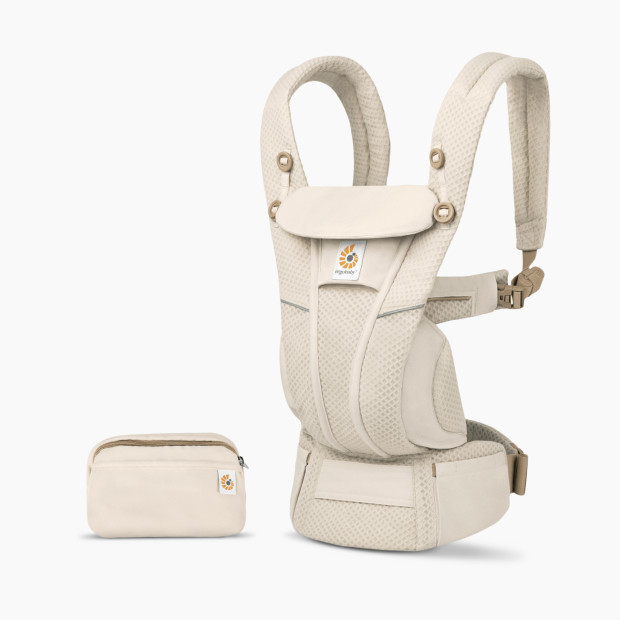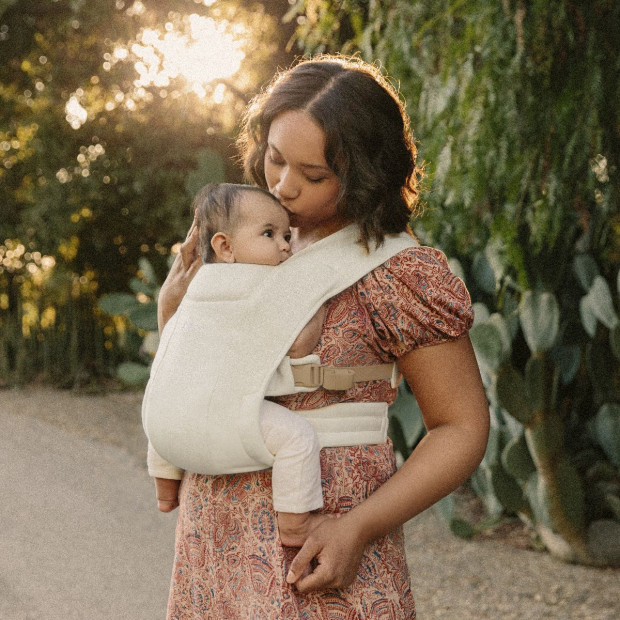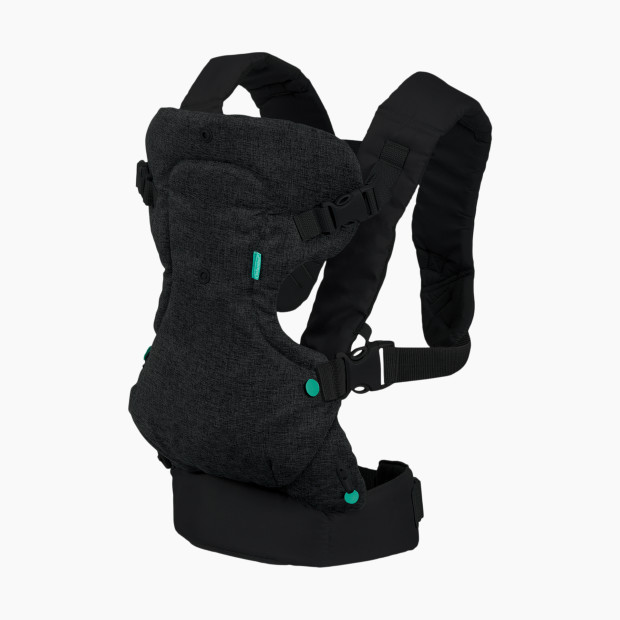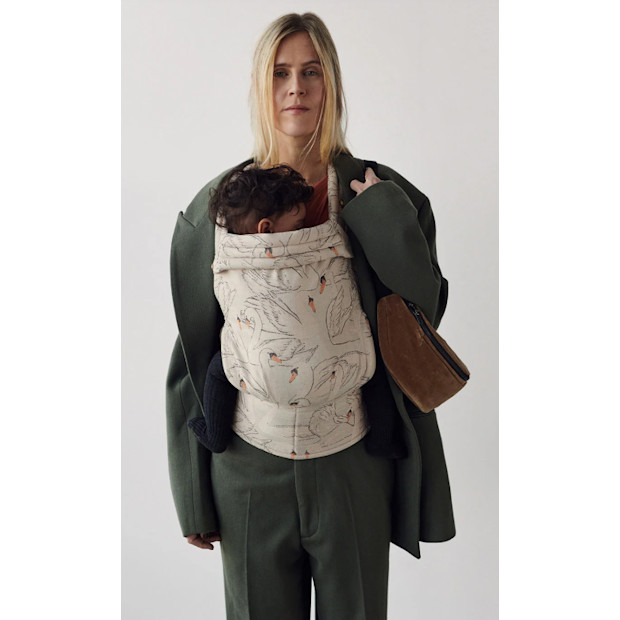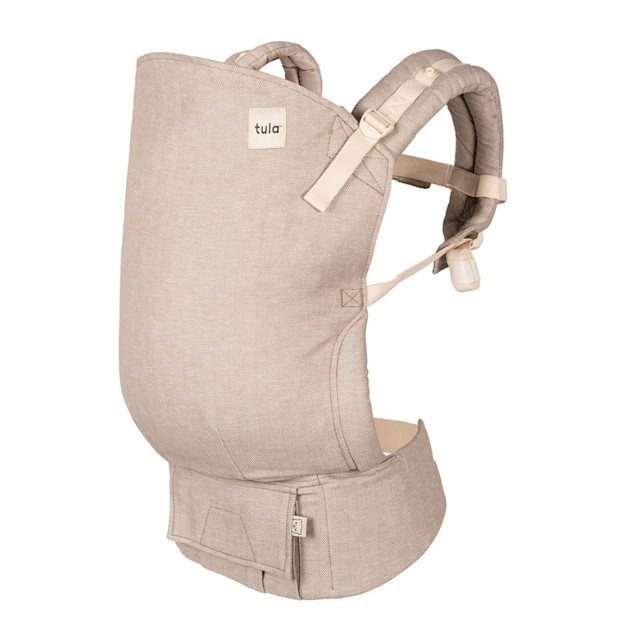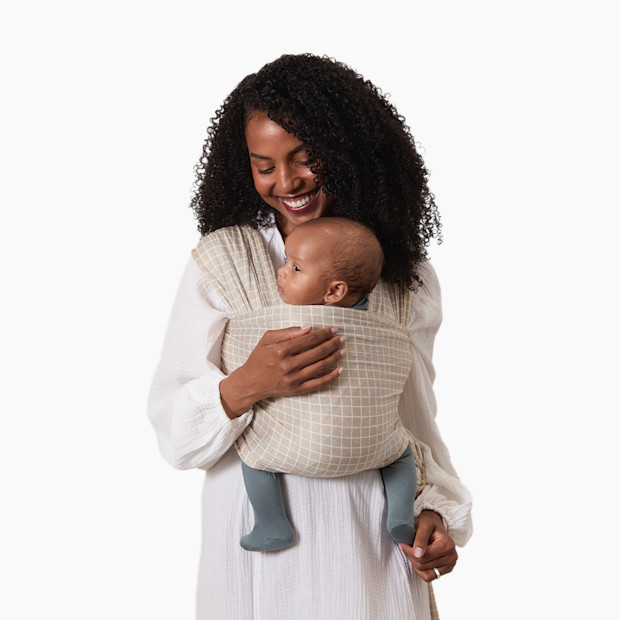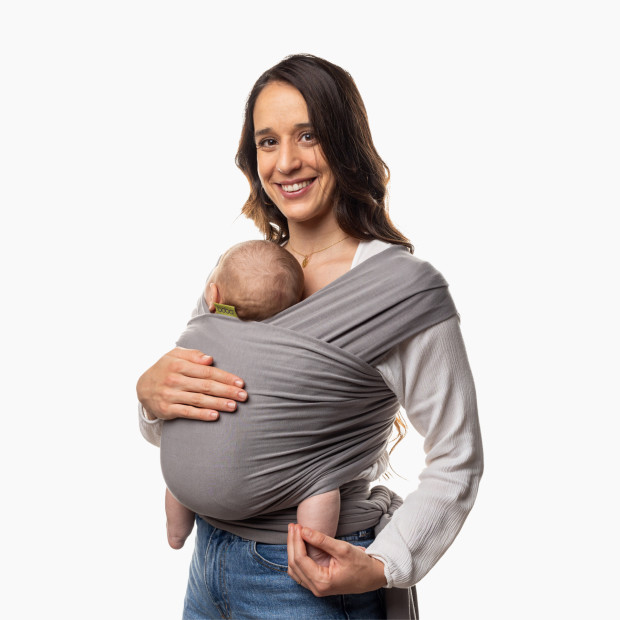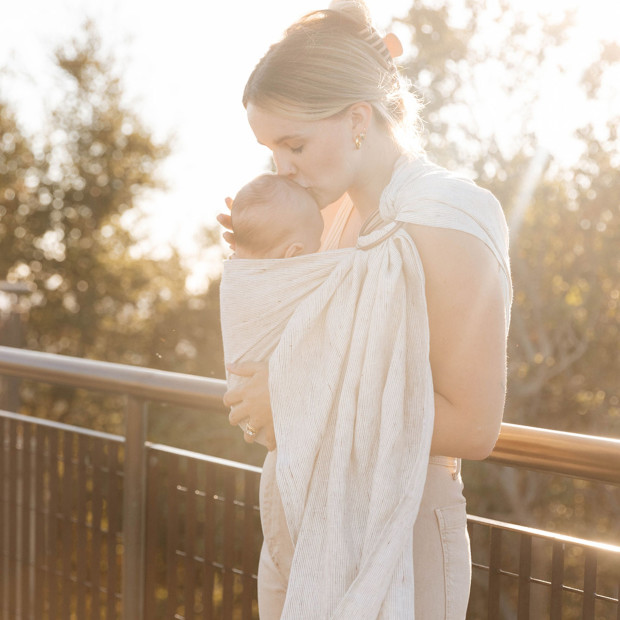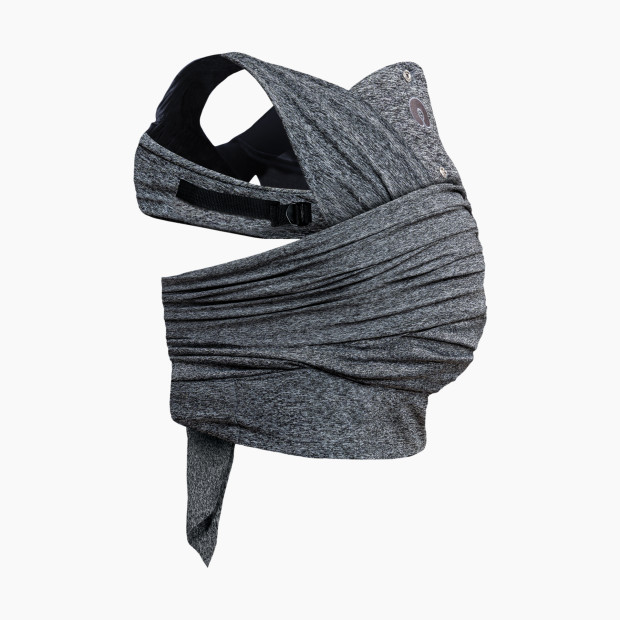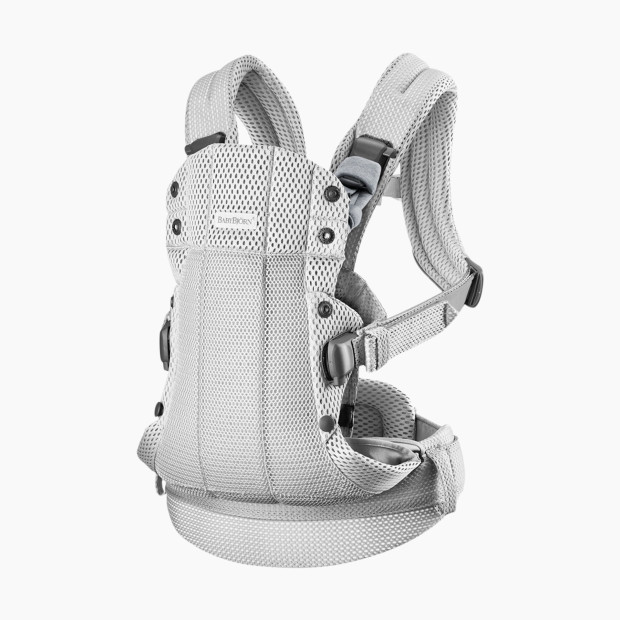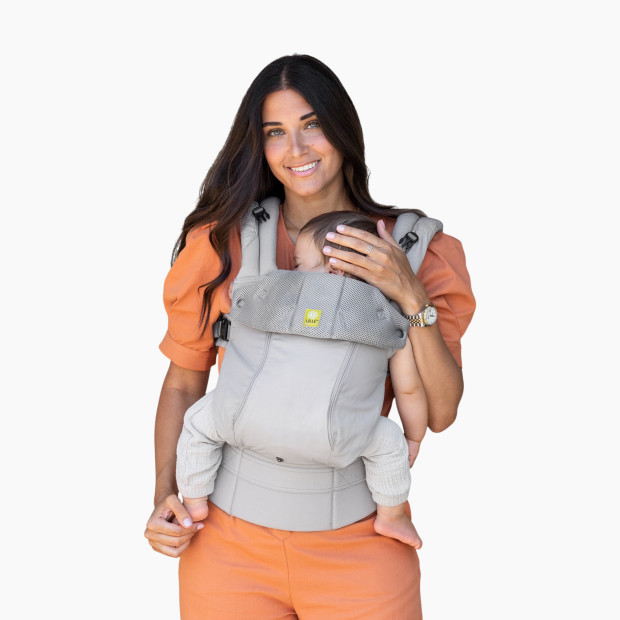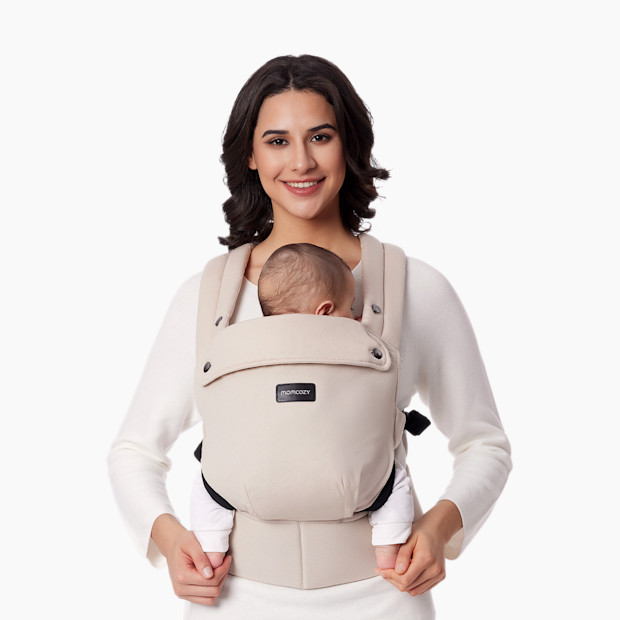
Best Baby Carriers of 2025, According to Parents and Experts
The best wraps, slings, structured carriers and hybrids, according to parents and experts.

By Jen LaBracio, CPST
Medically Reviewed by Krupa Playforth M.D.
Fact Checked by Shannon Vestal Robson
In This Article
Babies love to be held. But toting your little one around all day isn’t really feasible unless you have arms of steel and an army of helpers to do your daily tasks.
That’s where a baby carrier comes in. A good baby carrier does two key things: helps comfort and soothe a fussy little one and frees up your hands so you can get things done while still staying close to your new addition. Most parents-to-be add at least one carrier to their baby registry.
We waded through the wide world of babywearing and narrowed down the top three picks. If you’re shopping for a structured carrier, we think the Ergobaby Omni Breeze Baby Carrier is the best option. Looking for a wrap? We recommend the Solly Baby Wrap Carrier. And if a hybrid is on your must-have list, Boppy’s ComfyFit Adjust Hybrid Baby Carrier is the best choice for most families. (You’ll be able to read all about the different types of baby carriers—and how to choose what’s best for you—later in this guide.)
And since babywearing is all about options, we also chose several other top picks in each of these categories for you to consider and shop.
How We Judged Baby Carriers
Baby carriers are very subjective; what works for one parent might not work for another. Keeping that front of mind, we considered the following features when testing and selecting the top choices for our best baby carriers list:
The Best Baby Carriers
Structured Baby Carriers
Best Structured Baby Carrier Overall
Pros
- Lightweight and ultra-breathable
- 4 carry positions and lots of adjustment options
- Stays cool in warm weather
Cons
- Can be tough to put on/adjust in certain carry positions
- Some parents think shoulder straps are thin/uncomfortable
Ergobaby’s Omni Breeze is my go-to carrier and the most popular baby carrier for Babylist parents, too; 21% of respondents in our Best Baby Products survey tapped it as their top choice. With praise like, “we use it almost every day and it keeps baby cool,” and “I love the ease of use and comfort for me and baby,” this multi-position carrier is a good choice for almost any family.
The first thing I noticed after unboxing this carrier is the incredibly soft, lightweight fabric. I’ve owned other Ergobaby carriers in the past, but the Breeze’s fabric is like nothing I’d felt before. Covered in a special mesh, it’s incredibly breathable and was comfortable to wear even on very warm days. That’s not the case with lots of other soft structured carriers (SSCs).
The carrier’s versatility is my second favorite feature. Front-inward, front-outward, back and hip carries are all doable with this carrier. (I’ve used front and back carries the most, but have tried every position.) It was just as comfortable when my baby was a newborn as it was through toddlerhood. And, because of the ergonomic design and adjustment options, worked for both me and my husband despite our differing heights and body types.
Like most soft structured baby carriers, the Breeze can be tricky to get on by yourself, especially the first few times you use it and if you’re trying a back carry position. With a bit of practice, though, I got the hang of all the different carry positions pretty quickly. I’d also like to give a shout-out to the detachable storage pouch. It saved me from having to lug along a much larger (and much heavier) diaper bag on more than one occasion thanks to its just-right size.
Additional Specs
Weight limit: 7-45 lbs
Available positions for baby: front-inward, front-outward, hip, back
Other Structured Carriers We Love
Best for Newborns
Ergobaby Embrace Carrier - Cream
From $73.99Pros
- Super soft, newborn-friendly fabric
- 52” waist strap fits a wide range of adult sizes
- Slim and portable
Cons
- Won’t work with smaller newborns
- No pockets
- Low max weight
The Embrace is one of my favorite products to recommend to first-time parents looking to ease into the world of babywearing. It’s also the first carrier when I hear someone say, “I don’t think babywearing is for me; it feels too overwhelming.”
A bit of a hybrid, the Embrace brings together the softness of a wrap with the ease and support of a more structured carrier. Think of it as a structured carrier “light”: it goes on easily in less than a minute, there’s no back strap to fumble with, it’s comfortable for you and for baby and it’s an easy way to keep baby close and soothed, especially during the fourth trimester. “I never used my carrier with baby number one and loved how soft, easy, [and] lightweight [the Embrace] was for baby number two,” one mom told us.
The Embrace is designed especially for the first year or so (from birth or seven pounds up to 25 pounds), but I find it really shines during the newborn phase when you need a quick, easy way to calm your little one. It’s also compact enough to stash in your diaper bag or backpack. And as your baby gets older, you can use the outward-facing carry option. Just keep in mind that you’ll want to switch over to a more substantial structured carrier with a higher age and weight limit as your little one grows. And many parents wish the carrier came with a storage option and a hood.
Additional Specs
Weight limit: 7-25 lbs
Available positions for baby: Newborn, front-inward, front-outward
Best Affordable
Infantino Flip 4-In-1 Convertible Carrier - Black
From $27.45Pros
- Extremely affordable
- Four carry positions
- Adjustable, including seat width
Cons
- Newborns and smaller babies often require more support
- Gets less comfortable as baby grows
If you're unsure how often you'll babywear or you don't want to spend hundreds of dollars on a carrier, the Infantino Flip is a fantastic deal and a fantastic carrier for the price. While not quite as supportive or durable as pricier baby carriers, it has a lot going for it considering the price. It fits kids and parents of all sizes thanks to the numerous points where you can adjust straps and buckles. The convertible seat can be narrow for newborns or made wider for bigger kids to keep legs in a hip-healthy position. And, there’s no overheating in this carrier—it’s lightweight and breathable for both you and your little one.
"I received this off-registry and my baby and I LOVE it. We still use it frequently," one parent told us. "It's a lifesaver to allow you to have your hands back while your baby relaxes."
The biggest complaint about this carrier is that it doesn't work as well for older and larger babies. Some parents also find this carrier works better for newborns when you add a rolled up towel or blanket to the bottom of the seat to act as a booster.
Additional Specs
Weight limit: 8-32 lbs
Available positions for baby: front-inward (narrow or wide), front-outward, back
Easy and Lightweight
Pros
- 100% linen is soft, breathable and lightweight
- Padded straps and waistband
- Quick and easy to get on
Cons
- Sized for wearer (although size ranges are wide)
- Expensive considering only 2 carry positions
The baby carrier market is crowded, and it's not easy for a newcomer to stand out—but WildBird's Aerial is already a parent favorite despite its newbie status. "Worth its weight in gold," is how one parent from our Favorite Baby Products survey described it. That's because the WildBird is the perfect combination of form and function. It's ergonomic, comfortable for both babies and babywearers and it's beautiful.
Made from 100% natural linen, the Aerial is soft against the skin and breathable. It's a good choice in any climate, even warmer ones. Because of the design, it's also easy to put on by yourself. "One of the most important features of a baby carrier for me is being able to put it on without help since I am usually using it when I am solo to keep my Velcro baby relaxed," says Latifah, Babylist's commerce editor and a mom of two. "The straps have a simple criss-cross attachment and are super easy to put on and tighten."
Parents also love this carrier's thick, padded straps and waist belt, the mesh lining and that you can use it from the newborn days well into toddlerhood. And the color options are 😍. Just note the carrier does come in sizes, and while each size does cover a wide range, you may not be able to share the carrier with everyone. (Some parents say the carrier runs small, though we haven't found that to be the norm. WildBird does recommend sizing up if you're between sizes, however.) There are also only two carry positions: front-inward and back.
Additional Specs
Weight limit: 7-45 lbs
Available positions for baby: front-inward, back
Most Stylish
Pros
- Beautiful, unique designs
- Comfortable and easy to put on
- Slim & lightweight
Cons
- Very pricey
- Not machine washable
- No pockets or hood
As a baby gear expert, I get asked all the time if the Artipoppe baby carrier is “worth it.” While nothing stands out about the carrier’s function (it’s a great carrier, but so are many others at much lower price points), there’s no denying its style. And if it makes you feel better about yourself, better about parenthood and simply better all around, then I’m all for it.
“I just felt so luxe wearing it,” “It makes you feel glamorous as a mom,” and “I would get loads of compliments every time I wore it out,” are just a few of the glowing reviews parents shared with us about this iconic carrier in our Best Baby Products survey. And we get it! From denim, clouds and leopard, you simply won’t find anything that compares style-wise to this unique carrier.
And thankfully, these carriers boast more than just good looks. The Zeitgeist is super easy to put on (making it ideal even for the early days of babywearing) and can be used from seven pounds up until your little one is about two years old. There are also three carry positions and padding on the shoulder straps, waistband and around each leg opening.
The elephant in the room, of course, is the price. The Artipoppe is definitely a splurge, especially if you want one of the fancier fabrics, Also know that some of the styles and fabrics are tricky to clean.
Additional Specs
Weight limit: 7-45 lbs
Available positions for baby: front-inward, front-outward, back
Best for Toddlers
Pros
- High weight limits (25-60 lbs)
- Extra padding for comfort
Cons
- Tough to put on in back carry mode
- Back strap is tough to reach/buckle
Babywearing doesn’t have to come to an end as your little one grows. This carrier from Tula is specially designed for toddler carrying, with thicker shoulder straps and more lumbar support. You’ll be able to use it from two years old until your little one hits 60 pounds, which for many kids is elementary school age. It’s made textured linen and comes in many fun prints and colors.
Most parents find the back carry position the most comfortable for older kids. Just note that back carries do take some practice, and you’ll likely need help from another adult as you try to master it. But once you get it down, most parents find it a great way to transport an older toddler who may be resisting the stroller but not quite ready to walk longer distances on their own.
For another toddler-friendly carry option, check out the Tushbaby. It’s a hip seat carrier and while it’s not hands-free (you need to keep one arm around your little one), parents love it for the convenience and comfort.
Additional Specs
Weight limit: 25-60 lbs, 2-6 yrs old
Available positions for baby: front-inward, front-outward, back
Wraps and Slings
Best Baby Wrap Overall
Pros
- Lightweight, breathable, super soft Modal fabric
- Universal fit (works great for petite and plus-size adults)
- Parent favorite
Cons
- Learning curve
- Fabric is really long, especially for petite adults
- Not a good option for babies smaller than 8 lbs or larger than 25 lbs
Over and over again we hear parents swooning over their Solly wrap. “So soft and easy to use,” “crucial in those first few weeks home with a newborn,” and “just makes life so much easier” are just a few of the I-can’t-live-without-it comments we heard from parents when we asked them about the Solly in our Best Baby Products survey. “It’s one [of] the most useful things I registered for with my first and [I] will use the same one with my third,” another mom told us. “Most other things have changed but this has stayed a constant.”
The Solly is the wrap parents reach for again and again thanks to its super soft, lightweight fabric, ease of use and comfort factor, especially during those first few months of your baby’s life. Babies love it because they feel safe and secure; parents love it because it lets them keep baby close while freeing up their hands to do other things. It’s made in the USA from sustainably sourced materials and is easy to fold up compactly in its self-enclosing pocket to store in your stroller or diaper bag, another perk. And, it’s size-inclusive. (For a full list of size-inclusive baby carriers, check out our Best Baby Carriers for Plus Size Parents guide.)
The biggest downside of the Solly—and the downside of all wraps—is the learning curve. It takes practice (a lot of practice, if you’re me) to learn how to get it on and properly position your baby. How-to videos are your friend here—watch them. I also found it less stress-inducing to put the wrap on in the comfort of my home even if I was going to use it on the go, like to the grocery store, for example. I’d do most of my wrapping at home then pop baby in and finish any adjustments once I arrived at my destination.
Note the Solly only offers one carry position: front-inward. Although it works with babies up to 25 pounds, many parents like to use it while their baby is still young and then move on to a carrier with more positioning options as their little one grows.
Additional Specs
Weight limit: Newborn to 25 lbs
Available positions for baby: Front-inward
Best Affordable Wrap
Boba Baby Wrap Carrier - Grey
From $31.99Pros
- Affordable
- Universal fit
- Thicker fabric good for cooler climate, holds it shape well
Cons
- Heavier fabric can cause some wearers to overheat quickly
- Learning curve
- One carry position (front-inward)
If you want a wrap but don’t want to spend a ton of money, check out the Boba. Like the Solly, it’s made from one large piece of fabric and can be used in one position: front-inward. It fits parents of all sizes and can grow with your little one up to about 35 pounds (ten pounds higher than Solly’s 25-pound limit). And because it’s made from five percent spandex, it does a great job of helping babies feel snug and secure. This is especially great for newborns who love skin-to-skin. “We would not have survived the first two to three months without it. It was often the only way to calm [my baby] down and allow me to do anything,” one parent told us.
Since it’s made from thick cotton (the Solly is made from Modal), many parents say the wrap stays tight around baby longer than stretchier wraps might. But on the flip side, because of this thicker fabric, it can get hot. If you live in a warmer climate or run warm, consider Boba’s Serenity Baby Wrap Carrier. It’s a lighter, more breathable version of the brand’s classic wrap made from a soft bamboo fabric blend. Parents do note you’ll have to adjust it more frequently to ensure the fabric stays taught around your baby, though.
Additional Specs
Weight limit: Newborn to 35 lbs
Available positions for baby: Front-inward
Best Ring Sling
Pros
- Stylish & heirloom quality fabric
- Easy to adjust on the go
- Fabric is thick, sturdy & gets softer with every wash
Cons
- Pricey
- Not a universal fit
- Can be tricky to put on the first few times
Ring slings are a popular choice for many babywearing parents because they’re adjustable, fit most body types and are pretty easy to get the hang of and wear comfortably. They also offer three carry positions: front, hip or back.
Wildbird slings are some of the best and most beautiful ring slings on the market. They’re made from premium Belgian linen that gets softer and softer after each wash and use low-impact, all-natural environmentally-friendly dyes. This baby sling can be worn four ways and comes in two lengths: standard (74 inches) and long (90 inches) for plus-size wearers or parents over six feet tall.
Like with all wrap-style carriers, they do take some practice. Wildbird has a great collection of video tutorials that will help you get the hang of wearing your baby in a ring sling. And because the sling only distributes weight to one side of your body, they’re not comfortable for extended wear.
Additional Specs
Weight limit: Newborn to 35 lbs
Available positions for baby: Front, hip or back
Hybrid Baby Carriers
Best Hybrid Baby Carrier
Boppy ComfyFit Adjust Hybrid Baby Carrier - Heather Gray
From $41.99Pros
- Soft and comfy
- Supportive
- Adjusts quickly with waist clip
Cons
- May not fit well on more petite wearers
- Can be somewhat complicated to put on
- Older babies may grow out of it before hitting the max weight (35 lbs)
If you’re struggling with mastering a baby wrap but are still looking for a carrier that provides similar closeness, consider the ComfyFit Adjust from Boppy. It’s what’s known as a hybrid carrier: a carrier that combines the comfort of a wrap with the ease and support of a more structured carrier.
The ComfyFit Adjust is a three-position carrier made from soft, breathable fabric with a touch of spandex and goes on in three steps. There’s a padded waist belt for extra support and wide shoulder straps to help distribute weight, features you won’t find on a baby wrap or a ring sling. I also like the zippered pocket; it’s just the right size for stashing your phone, keys and a credit card or two.
The “adjust” part of the carrier’s name refers to the adjustable waist belt and arm straps to fit more bodies. It’s an upgrade from the original carrier and a very welcome one, making the ComfyFit much more size inclusive.
Additional Specs
Weight limit: 8-35 lbs
Available positions for baby: Front-inward, front-outward
Another Great Hybrid
Konny Baby Wrap Carrier Flex Airmesh - Cream, M-4 Xl
From $59.99Pros
- Easy to put on
- Breathable mesh keeps you (and baby) cool
- High weight limit
Cons
- Must be washed alone and in cold water
This hybrid carrier is another good choice if you want the closeness of a wrap with fewer complications than a structured carrier. It goes on like a T-shirt and takes about a minute. (Most other wraps require at least a few minutes of very specific movements and wrap angles.) It’s also designed to ensure your baby’s head stays above the carrier on your chest—a safety feature I really like.
Depending on your baby’s size, the Konny works from birth until about 12 months. It also features 13 adjustments to help wearers get the right fit. (You do have to pick a wrap size, but it’s a wide range—XS-XL, for example—so most wearers of different sizes will still be able to share the same wrap.)
The Konny is made from polyester and elastane. The benefits are that the carrier is lightweight and breathable. But the material can be harder to wash (you can pop it into the washing machine, but it must be washed alone with cold water).
Additional Specs
Weight limit: 8-44 lbs
Available positions for baby: Front-inward
Best for Toddlers
Pros
- High weight limits (25-60 lbs)
- Extra padding for comfort
Cons
- Tough to put on in back carry mode
- Back strap is tough to reach/buckle
Babywearing doesn’t have to come to an end as your little one grows. This carrier from Tula is specially designed for toddler carrying, with thicker shoulder straps and more lumbar support. You’ll be able to use it from two years old until your little one hits 60 pounds, which for many kids is elementary school age. It’s made textured linen and comes in many fun prints and colors.
Most parents find the back carry position the most comfortable for older kids. Just note that back carries do take some practice, and you’ll likely need help from another adult as you try to master it. But once you get it down, most parents find it a great way to transport an older toddler who may be resisting the stroller but not quite ready to walk longer distances on their own.
For another toddler-friendly carry option, check out the Tushbaby. It’s a hip seat carrier and while it’s not hands-free (you need to keep one arm around your little one), parents love it for the convenience and comfort.
Additional Specs
Weight limit: 25-60 lbs, 2-6 yrs old
Available positions for baby: front-inward, front-outward, back
Why Trust Babylist?
Babylist is the expert in baby; we know baby gear inside and out. We talk with parents face-to-face in our showroom and on our user panels and hear from thousands annually via our Best Baby Products online survey. We know what items millions of expecting parents are adding to their baby registries.
Firsthand professional and personal experience. I’ve been babywearing on and off for over a decade with my two children, ages 10 and three. I’ve used almost every type of baby carrier, from wraps and slings to hybrids and structured carriers. I’ve also tested out dozens of baby carriers in my role as Babylist’s gear editor. Both of these experiences helped me narrow down the carriers that made it onto this list.
Expert interviews. In researching and writing this guide, we spoke to Cassidy Eisenfeld, a certified babywearing educator and creator of Let’s Talk Babywearing, and Whitney Casares, a board-certified pediatrician, maternal child health expert and author of Doing It All.
Baby carrier data. I regularly analyze which baby products our users are adding to their baby registries the most (and which ones they aren’t) and what our team of Merchandising experts—our buyers who are responsible for ensuring the Babylist Shop is stocked with the best and newest gear—is excited about. Studying this kind of data helped us choose which carriers to narrow in on and the best baby carriers to recommend to new and expecting parents.
Feedback and reviews. I reviewed comments and feedback from Babylist’s annual product survey of thousands of parents, read customer reviews from hundreds of Babylist users and spoke to parents on our staff about their real-life product experiences.
Types of Baby Carriers
Baby carriers come in four styles: wraps, slings, hybrids and structured carriers. Each has pros and cons; not all carriers work for all babies or all parents.
Wraps
A wrap is a super long piece of stretchy fabric you tie around your body, usually over your shoulders and around your midsection, to create a carrier for your baby. Wraps mimic the feel of the womb and are especially loved by newborns. Most come in one-size-fits-all and easily adjust to different body types, but can take a bit of practice to get the hang of. “I do recommend stretchy wraps, even though they can feel really intimidating,” says Eisenfeld. “I find if people start when they're pregnant, it can really help.”
Pros:
Work for a wider range of sizes and body types
Softer and more lightweight than other types of carriers
Cons:
May not feel like the most secure fit
Tend to stretch out over time
Steep learning curve
Slings
A sling is a wide piece of fabric that goes over one shoulder and across your torso to create a pouch for your baby to sit in. Slings are generally easy to use. They’re also good for hotter climates as they are generally fairly lightweight. Since they rest on one shoulder, slings don’t distribute weight evenly, making them uncomfortable for long-term wear.
Pros:
Work for a wider range of sizes and body types
Softer and more lightweight than other types of carriers
Fairly easy to get on
Cons:
Don’t distribute weight evenly
Not great for lengthy wear
Limited carry positions
Structured carriers
Also called soft structured carriers (SSCs), structured carriers are worn like a backpack with straps over the shoulder and a padded carrying “pack” that can be placed on your chest or back. SSCs are usually designed with older babies in mind but many can be worn with younger babies, too. They offer lots of support and carry options (front, back, hip, etc.) and many can be used well through toddlerhood.
Pros:
More supportive, multiple carry options
Higher weight limits
Easier to put on and adjust
Cons:
Pricier than other carrier styles
Not as soft or comfortable as wrap carriers
Tend to get hot and sweaty in warm weather
Hybrids
Hybrid carriers provide the best of two baby-carrying worlds: a wrap and a soft structured carrier. Parents like hybrids because they are generally very easy to use and comfortable to wear, however, it can sometimes be tricky to find the right fit for every body type. Not all are size-inclusive, according to Eisenfeld.
Pros:
Great balance of soft + supportive
Not bulky
Easy to adjust
Cons:
Fewer carrying options than wraps
Can be complicated to put on
Do I Need a Baby Carrier?
A baby carrier isn’t a necessity. You can use a stroller when you’re out and about and a bouncer or swing at home. But if you ask parents, many will tell you that their baby carrier is one of their favorite pieces of baby gear, regardless of the type of brand.
Baby carriers free up your hands to do other things while your baby is safely resting against you. They’re great for calming down a fussy baby, especially during the first few months of your little one’s life when seemingly nothing else will do the trick, but many can work well into the toddler years, too. Carriers can help you keep your baby close while you navigate crowded spaces like airports, museums or stadiums. They’re also great if you like hiking and want to bring your little one along. And most are small enough to fit easily in a tote, under a stroller or even in a diaper bag.
How to Choose a Baby Carrier
Tips for choosing a baby carrier
Babywearing is intimidating, especially if you’re a first-time parent. There’s also no one-size-fits-all approach. “There are various baby carriers on the market,” says Dr. Casares. “Soft or hybrid models allow babies to snuggle up close to caregivers and can provide better mobility for the person wearing the carrier. For longer walks/hikes, I prefer structured carriers. Every caregiver is different and may prefer one style or another.”
If you’re trying to figure out how to choose a baby carrier or wondering which one(s) to add to your baby registry, here’s what to consider.
Longevity: How long do you plan to use your baby carrier? If you want a carrier that lasts through the toddler years, look for one with a high weight limit and multiple carry positions. If you plan to babywear mainly during infancy, consider one that’s easy to get on and creates a cozy environment for your little one.
Fit: Ensure the baby carrier you like fits your particular body. If you plan on sharing your carrier with a partner or caregiver, you’ll need one that easily adjusts to different body sizes.
Comfort: Be sure the seat of any carrier allows your baby’s legs to be in the hip-healthy “M” position. (More on that below.) For you, think about comfort features like back and shoulder support.
Ease of use: Putting on a wrap is a multi-step process, while a structured carrier is much more straightforward. Be sure you’re willing to put in the work if you choose a more complex wrap or carrier. Also, think about the size of your baby carrier. A wrap or a sling easily tucks into a diaper bag, while a soft structured carrier will take up more space.
Material: If you live in a warm climate, or just run hot, choose a baby carrier made from lightweight, breathable fabric.
Care: Babies are messy, but not all carriers are machine washable. Check labels for washing instructions.
Keep in mind that there is a learning curve with baby carriers, especially certain styles. Try not to get discouraged if you can’t figure things out on the first try (or two, or three). Get familiar with the world of babywearing, utilize your carrier brand’s video tutorials and practice, practice, practice—it will pay off. You can also check out our baby carrier FAQ and the baby carrier glossary for carrier and babywearing lingo.
Einsenfeld also recommends new parents start their carrier search by asking friends so they can see the carriers in person. “The hardest part when you're looking online is that there are so many options. And when you're looking at hundreds of images, it can get really, really stressful,” she says. If possible, try on your friends’ carriers, or find a store that has a few you’re considering. “Just go feel them, put them on your body. It can be really helpful.”
Baby Carrier Safety
Babywearing is one of the best ways to keep your baby calm and close to you. But it’s crucial to educate yourself on baby carrier safety and learn how to properly use whichever baby carrier you choose.
Remember TICKS
The acronym TICKS is a helpful place to start when you’re using a baby carrier.
T. Tight
I. In view at all times
C. Close enough to kiss
K. Keep chin off the chest
S. Supported back
Always be sure you’re using your baby carrier exactly as directed. (For example, ensure your baby is facing the correct direction for their age). Double-check that all buckles and knots are securely fastened. And, most importantly, be sure you’re monitoring your little one’s breathing at all times. Always keep your baby’s face in view and ensure their chin never touches their chest.
Learn about proper hip positioning
When done properly, babywearing can encourage your baby’s healthy hip development. But when done incorrectly, it can have the opposite outcome, causing hip dysplasia, a condition where your baby’s hip joint may become partially or completely dislocated.
The M-position is recommended for hip-healthy babywearing. Be sure your baby’s thighs are spread around your torso and baby’s hips are bent so that their thighs are supported and their knees are slightly higher than their bottom. Thighs should be:
Flexed
Supported
Spread apart
“One [thing to keep in mind] is ensuring they've got a good pelvic tuck, which tucks their body towards you,” explains Eisenfeld. “This will ensure they're in a good position for their hips.”
Less spread with more flex is healthy, and slightly more spread with less flex is fine as your little one grows. Consult the International Hip Dysplasia Institute for a list of all hip-healthy baby carriers.
Pay extra attention with newborns
Because newborns lack any head or neck control, you need to be very conscious about proper babywearing and ensuring they’re correctly supported in a carrier.
If you’re using a wrap-style carrier, be sure it’s tight enough and snug to your body, says Eisenfeld. “Lots of parents, especially when using stretchy wraps, end up wearing them really loosely thinking they don't want their baby to be too tight,” she says. “And that actually puts their baby at a lot of risk.” She compares a carrier to the feel of a well-fitted t-shirt.
Be sure your newborn’s head is upright and completely visible. “Your carrier should be supporting your baby in a way that their head is not flopping. And ensure that the carrier is not over their face, it's just over the back of their head.”
If you’re using a structured carrier, fasten the waist belt higher up on your body. “With a lot of the buckle carriers, you'll actually want to start with them sitting significantly higher when they're younger,” she explains. This will help ensure the correct pelvic tilt and make it easier for you to look down and keep an eye on them.
Don’t rush to outward-facing
“Keep your baby inward-facing until they are five months of age and their neck muscles are strong enough to support them facing outward,” says Dr. Casares.
Eisenfeld echoes this recommendation. “The absolute minimum requirement is four to six months with strong head control,” she says. She also recommends not exceeding 15 to 20 minutes at a time. Front-outward facing can be overstimulating for a baby. It can also put added pressure on the birthing person’s pelvic floor and make it tough to see if your baby is getting tired. (Sleeping in an outward-facing position is not recommended because of the risk of asphyxiation.)
Watch the clock
“There's no official time limit for baby carrying,” says Dr. Casares. “That said, babies need plenty of different positions for healthy physical and social development. Parents should give their little ones plenty of opportunities to explore their environments outside of baby carriers.”
If your baby falls asleep in the carrier, watch them consistently to ensure they are positioned correctly and can breathe easily. “As soon as possible, transfer them to a safe, flat sleeping area,” she says.
Baby Carrier Frequently Asked Questions
Are baby carriers good for newborns?
Baby carriers can be beneficial to children for years, but they’re especially good for newborns. Newborns love skin-to-skin contact and thrive off of feeling snug and secure—and a baby carrier is a safe and comfortable way for you to provide this. Baby carriers also give your arms a break and free up your hands if you need to get other things done. However, it is important to choose a carrier that is appropriate for your baby’s age and development and to follow safety guidelines when using it, especially with a very young baby. It is also recommended to consult with a healthcare professional before using a carrier with a newborn.
Which baby carrier is easiest to breastfeed in?
When looking for a breastfeeding-friendly baby carrier, focus on options that allow easy access to your breasts and are easily adjustable. Popular options include ring-sling or wrap-style carriers and certain structured carriers with adjustable straps or panels. And remember, nursing and babywearing may not be easy at first—try not to get too stressed out and practice, practice, practice.
Which baby carrier is safest for my back?
If you have a bad back or are concerned about putting too much stress on your back while babywearing, look for a carrier that distributes your baby’s weight over both shoulders and around your waist. Focus on features like wide, padded shoulder straps, an ample waist/hip support belt and plenty of adjustable straps and buckles. Avoid any baby carrier that doesn’t have a waistband or that only goes over one shoulder (such as ring slings, Onbuhimos or any hip carrier).
Stretchy wraps fit the bill for the newborn days because you can spread the fabric wide across your shoulders and back, which will help with weight distribution. However, once baby reaches about 15-20 pounds, stretchy wraps aren’t as supportive and it’s best to move to a well-fitting soft structured carrier.
How many baby carriers do I need?
How many baby carriers do you NEED? None. But how many will you WANT? That’s another story. Most parents choose to add at least one baby carrier to their baby registry. Many add two: a soft, stretchy wrap for the newborn days and a structured carrier for toddlerhood and beyond. And if you’ve completely fallen in love with babywearing? The world of baby carriers offers so many fabrics, colors and styles—have fun!
